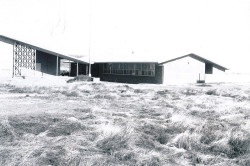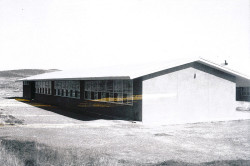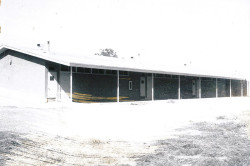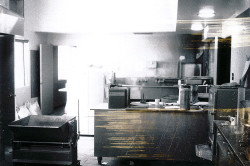
The school history of Armona Union Academy began in 1903 in the home of Nis Hansen and was taught by Nellie brown. As the student body grew from the original four to thirteen by April, the classroom moved to the Hansen’s buggy house and later to a nearby cottage, all on the Hansen’s ranch. By October, 1906 it became known as the Central California Intermediate and Church School under direction of B.L. Howe.
School History: The Next Phase of Growth
 Nis Hansen donated five acres of land on which was built a church and the old Armona Library which housed a student body of 70 pupils. Community homes boarded nonresident students during the week. In 14909 the enrollment reached 90 and a new schoolroom was added. Myrtle B. Hudson, a physician from Battle Creek sanitarium, joined the staff as a science teacher and conducted temperance and health clinics in the community.
Nis Hansen donated five acres of land on which was built a church and the old Armona Library which housed a student body of 70 pupils. Community homes boarded nonresident students during the week. In 14909 the enrollment reached 90 and a new schoolroom was added. Myrtle B. Hudson, a physician from Battle Creek sanitarium, joined the staff as a science teacher and conducted temperance and health clinics in the community.
In 1911, J.L. Jones arrived from Union College and instruction was offered through grade 2, and the first year Armona Academy graduated 5 seniors. In 1913, the Pacific Union Conference requested that academies restrict their curriculum so as to strengthen the Pacific union College program. As a result, Armona Academy was reduced to a ten-grade school and placed under local control. In 1925 the constituent churches of Island, Laguna, Lemoore, Hanford and Armona consolidated their small schools, bought two busses and united as the Armona Union Intermediate School.
 This school operated within the old academy building and in 1928 was accredited by the General Conference department of Education. The school expanded to include ninth, tenth and eleventh grade subjects and by 1935 was considered to be operating to capacity with an enrollment of 94.
This school operated within the old academy building and in 1928 was accredited by the General Conference department of Education. The school expanded to include ninth, tenth and eleventh grade subjects and by 1935 was considered to be operating to capacity with an enrollment of 94.
School History: Disaster Strikes
Monday afternoon, Feb.24, 1936, a fire destroyed the wooden structure and only a piano, a few books, and maps were salvaged. Within two weeks plans were approved to rebuild a larger facility to accommodate 100 students. The community and the constituents rallied with pledges exceeding $5,000 plus materials and time.
Dr. W. A. Johnstone was the rallying force, organizer and inspiration to direct the rebuilding. Crews of men worked double shifts, making adobe bricks from 4 to 9 a.m. and then pursing regular occupations. Classes met in tents and the Armona Church for the remainder of the school year. By the fall of 1936, four new classrooms were opened along with an office. By the following year a 300 seat auditorium, plus a mechanical drawing and woodworking facility was completed.
 The fall of 1939 saw the full 12 grades being offered to a student body of 135. By this time the adobe building had been stuccoed, the insides plastered and a new home economics room begun. In 1949, three new classrooms and a cafeteria were added for the elementary and two duplexes for faculty housing as well as a metal shop building for vocational subjects. The vocational complex was named to honor Dr. Johnstone who had been so instrumental in the rebuilding of the school.
The fall of 1939 saw the full 12 grades being offered to a student body of 135. By this time the adobe building had been stuccoed, the insides plastered and a new home economics room begun. In 1949, three new classrooms and a cafeteria were added for the elementary and two duplexes for faculty housing as well as a metal shop building for vocational subjects. The vocational complex was named to honor Dr. Johnstone who had been so instrumental in the rebuilding of the school.
In 1955 the school was accredited by the General Conference department of Education. The following year under the leadership of Paul Plummer, the grounds were landscaped and the school exterior was painted. In 1957, Lambert Flory and others purchased ten acres across the street from the school in which they planted walnut and apricot trees and then donated it to the school.
School History: The Modern Era
Under Dallas Carr’s administration, 1969-1973, two of the duplex homes were remodeled, transforming them into a new home economics building and a pre-school unit. A modern air-conditioned elementary building was purchased from the Coaling School District and moved fifty miles to the site, and was refinished for occupancy. A four-room administration complex with intercom and air conditioning was also added, and the old elementary building remodeled and made into academy classrooms and science laboratory.
During the summer of 1978, the foundation was laid for the new gymnasium, multipurpose room, and kitchen, large enough to cater banquets and potlucks for the constituent churches. The annual harvest auction and the speaker was Elder H.M.S. Richards, Sr.
The old gymnasium was remodeled into a chapel and in 1993 was named to honor L.A. Hansen, whose family has been instrumental with many forms of constant support for 90 years.
The Armona Church is on the academy campus as well as the new Kings Crusaders Pathfinder Building which services the five-area churches. This building, completed in 1993, replaces the previous one destroyed by fire in 1989.
Armona Union Academy is a WASC-accredited co-educational senior high school sharing a campus with an elementary school in the San Joaquin Valley town of Armona, adjacent to the city of Hanford, California. The 17.5 acre campus of Armona Union Academy and Elementary School remains dedicated to the mission of supplying workers for the world-wide commitment of spreading the three angel’s messages. AUA is accredited by the SDA Board of Regents and is a charter member of the Western Association of Secondary Schools and Colleges through 2018. Today the school is owned by the Central California Conference of Seventh-day Adventists and operated jointly by the Central California Conference and the five constituent churches (Armona, Corcoran, Hanford English, Hanford Spanish and Lemoore).
—
Principals of the Twelve-Grade Academy: J.L Jones, 1911-1913; R.N. Gardner, 1938-41; R. Shephard, 1941-44; W.F. Storz, 1944-46; Theophil Fischer, 14946-47; B.C. Clark, 1947-48; Helen Morris, 1948-49; B.E. Schaffner, 1949-53; M.A. Smith, 1953-56; P.E. Plummer, 1956-64; W.E. Minder, 1964-66; Norman Morris, 1966-68; E.F. Judy, 1968-69; Dallas Carr, 1969-73; Richard Stafford, 1973-74; James A. Hawkins, 1974-77; Curtis Church, 1977-82; Bob Evans, 1982-85; Ron Turner, 1985-87; Earl Spaulding, 1987-90; Lon Gruesbeck, 1990-92; Sam Geli, 1992-93; Donald Olson, 1993-96; Bill Wright, 1996-99; Marianne Gilbert, 1999-05 ; Rod Kerbs, 2005-07; Erik Borges, 2007-12; Jeanie de la Torre, 2012-13; Erik Borges, 2013-16; Randy Bovee, 2016-present.
